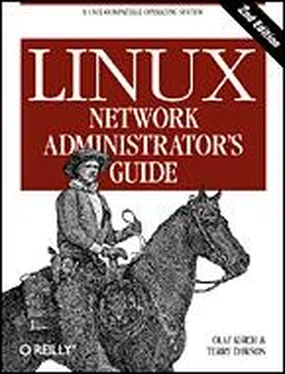We define a network as a collection of hosts that are able to communicate with each other, often by relying on the services of a number of dedicated hosts that relay data between the participants. Hosts are often computers, but need not be; one can also think of X terminals or intelligent printers as hosts. Small agglomerations of hosts are also called sites .
Communication is impossible without some sort of language or code. In computer networks, these languages are collectively referred to as protocols . However, you shouldn't think of written protocols here, but rather of the highly formalized code of behavior observed when heads of state meet, for instance. In a very similar fashion, the protocols used in computer networks are nothing but very strict rules for the exchange of messages between two or more hosts.
Modern networking applications require a sophisticated approach to carrying data from one machine to another. If you are managing a Linux machine that has many users, each of whom may wish to simultaneously connect to remote hosts on a network, you need a way of allowing them to share your network connection without interfering with each other. The approach that a large number of modern networking protocols uses is called packet-switching . A packet is a small chunk of data that is transferred from one machine to another across the network. The switching occurs as the datagram is carried across each link in the network. A packet-switched network shares a single network link among many users by alternately sending packets from one user to another across that link.
The solution that Unix systems, and subsequently many non-Unix systems, have adopted is known as TCP/IP. When talking about TCP/IP networks you will hear the term datagram , which technically has a special meaning but is often used interchangeably with packet . In this section, we will have a look at underlying concepts of the TCP/IP protocols.
Introduction to TCP/IP Networks
TCP/IP traces its origins to a research project funded by the United States Defense Advanced Research Projects Agency (DARPA) in 1969. The ARPANET was an experimental network that was converted into an operational one in 1975 after it had proven to be a success.
In 1983, the new protocol suite TCP/IP was adopted as a standard, and all hosts on the network were required to use it. When ARPANET finally grew into the Internet (with ARPANET itself passing out of existence in 1990), the use of TCP/IP had spread to networks beyond the Internet itself. Many companies have now built corporate TCP/IP networks, and the Internet has grown to a point at which it could almost be considered a mainstream consumer technology. It is difficult to read a newspaper or magazine now without seeing reference to the Internet; almost everyone can now use it.
For something concrete to look at as we discuss TCP/IP throughout the following sections, we will consider Groucho Marx University (GMU), situated somewhere in Fredland, as an example. Most departments run their own Local Area Networks, while some share one and others run several of them. They are all interconnected and hooked to the Internet through a single high-speed link.
Suppose your Linux box is connected to a LAN of Unix hosts at the Mathematics department, and its name is erdos . To access a host at the Physics department, say quark , you enter the following command:
$ rlogin quark.physics
Welcome to the Physics Department at GMU
(ttyq2) login:
At the prompt, you enter your login name, say andres , and your password. You are then given a shell [6] The shell is a command-line interface to the Unix operating system. It's similar to the DOS prompt in a Microsoft Windows environment, albeit much more powerful.
on quark , to which you can type as if you were sitting at the system's console. After you exit the shell, you are returned to your own machine's prompt. You have just used one of the instantaneous, interactive applications that TCP/IP provides: remote login.
While being logged into quark , you might also want to run a graphical user interface application, like a word processing program, a graphics drawing program, or even a World Wide Web browser. The X windows system is a fully network-aware graphical user environment, and it is available for many different computing systems. To tell this application that you want to have its windows displayed on your host's screen, you have to set the DISPLAY environment variable:
$ DISPLAY=erdos.maths:0.0
$ export DISPLAY
If you now start your application, it will contact your X server instead of quark 's, and display all its windows on your screen. Of course, this requires that you have X11 runnning on erdos . The point here is that TCP/IP allows quark and erdos to send X11 packets back and forth to give you the illusion that you're on a single system. The network is almost transparent here.
Another very important application in TCP/IP networks is NFS, which stands for Network File System . It is another form of making the network transparent, because it basically allows you to treat directory hierarchies from other hosts as if they were local file systems and look like any other directories on your host. For example, all users' home directories can be kept on a central server machine from which all other hosts on the LAN mount them. The effect is that users can log in to any machine and find themselves in the same home directory. Similarly, it is possible to share large amounts of data (such as a database, documentation or application programs) among many hosts by maintaining one copy of the data on a server and allowing other hosts to access it. We will come back to NFS in Chapter 14, The Network File System.
Of course, these are only examples of what you can do with TCP/IP networks. The possibilities are almost limitless, and we'll introduce you to more as you read on through the book.
We will now have a closer look at the way TCP/IP works. This information will help you understand how and why you have to configure your machine. We will start by examining the hardware, and slowly work our way up.
The most common type of LAN hardware is known as Ethernet . In its simplest form, it consists of a single cable with hosts attached to it through connectors, taps, or transceivers. Simple Ethernets are relatively inexpensive to install, which together with a net transfer rate of 10, 100, or even 1,000 Megabits per second, accounts for much of its popularity.
Ethernets come in three flavors: thick , thin , and twisted pair . Thin and thick Ethernet each use a coaxial cable, differing in diameter and the way you may attach a host to this cable. Thin Ethernet uses a T-shaped "BNC" connector, which you insert into the cable and twist onto a plug on the back of your computer. Thick Ethernet requires that you drill a small hole into the cable, and attach a transceiver using a "vampire tap." One or more hosts can then be connected to the transceiver. Thin and thick Ethernet cable can run for a maximum of 200 and 500 meters respectively, and are also called 10base-2 and 10base-5. The "base" refers to "baseband modulation" and simply means that the data is directly fed onto the cable without any modem. The number at the start refers to the speed in Megabits per second, and the number at the end is the maximum length of the cable in hundreds of metres. Twisted pair uses a cable made of two pairs of copper wires and usually requires additional hardware known as active hubs . Twisted pair is also known as 10base-T, the "T" meaning twisted pair. The 100 Megabits per second version is known as 100base-T.
Читать дальше



![Andrew Radford - Linguistics An Introduction [Second Edition]](/books/397851/andrew-radford-linguistics-an-introduction-second-thumb.webp)








